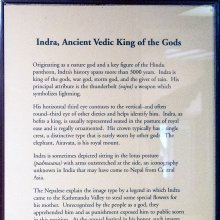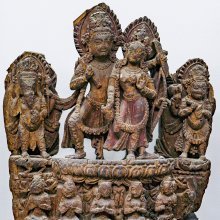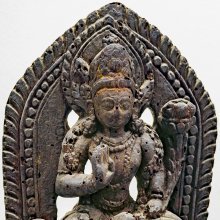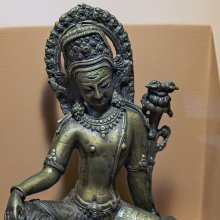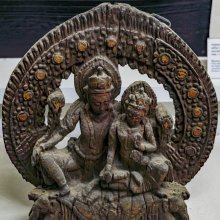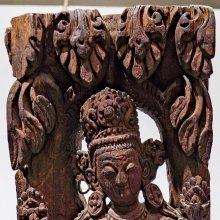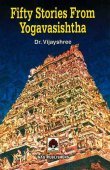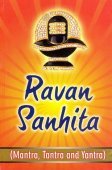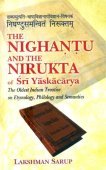Indra, Iṇḍra, Imdra: 60 definitions
Introduction:
Indra means something in Buddhism, Pali, Hinduism, Sanskrit, Jainism, Prakrit, the history of ancient India, Marathi, Hindi, biology. If you want to know the exact meaning, history, etymology or English translation of this term then check out the descriptions on this page. Add your comment or reference to a book if you want to contribute to this summary article.
Images (photo gallery)
(+36 more images available)
In Hinduism
Natyashastra (theatrics and dramaturgy)
Source: Wisdom Library: Nāṭya-śāstra1) Indra (इन्द्र) is a Sanskrit word referring to a deity. Acording to the Nāṭyaśāstra 1.88-95, when Brahmā, Indra and all other gods went to inspect the playhouse (nāṭyamaṇḍapa) designed by Viśvakarmā, he assigned different deities for the protection of the playhouse itself, as well as for the objects relating to dramatic performance (prayoga).
As such, Brahmā assigned Indra to the hero (nāyaka). The protection of the playhouse was enacted because of the jealous Vighnas (malevolent spirits), who began to create terror for the actors.
2) Indra is also to be worshipped during raṅgapūjā, according to the Nāṭyaśāstra 3.1-8. Accordingly, the master of the dramatic art who has been initiated for the purpose shall consecrate the playhouse after he has made obeisance (e.g., to Indra).

Natyashastra (नाट्यशास्त्र, nāṭyaśāstra) refers to both the ancient Indian tradition (shastra) of performing arts, (natya—theatrics, drama, dance, music), as well as the name of a Sanskrit work dealing with these subjects. It also teaches the rules for composing Dramatic plays (nataka), construction and performance of Theater, and Poetic works (kavya).
Purana and Itihasa (epic history)
Source: Wisdom Library: Varāha-purāṇaIndra (इन्द्र).—One of the nine divisions of Bhārata, a region south of mount Meru, according to the Varāhapurāṇa chapter 74. Indra is surrounded by an ocean (sāgara) and is one thousand yojanas in extent. Meru is one of the seven mountains located in Jambūdvīpa, which is ruled over by Āgnīdhra, a grandson of Svāyambhuva Manu, who was created by Brahmā, who was in turn created by Nārāyaṇa, the unknowable all-pervasive primordial being, who was created by Brahmā, who was in turn created by Nārāyaṇa, the unknowable all-pervasive primordial being.
Source: archive.org: Puranic EncyclopediaIndra (इन्द्र).—Genealogy. Viṣṇu—Brahmā—Marīci—Kasyapa—Indra. (See full article at Story of Indra from the Puranic encyclopaedia by Vettam Mani)
Source: archive.org: Nilamata Purana: a cultural and literary studyIndra (इन्द्र) refers to a deity that was once worshipped in ancient Kashmir (Kaśmīra) according to the Nīlamatapurāṇa.—Indra is described as honoured by and as refuge of the gods. The bright half of Prauṣṭhapada is dedicated wholly to his worship and is given the name Indra pakṣa. Reference is made to his wife Śacī, his gaṇas, his weapons and his mount. His images erected by six sages, namely, Pulastya, Śakra, Bharadvāja, Kaśyapa, Kaṇva and Agastya are mentioned.
Source: archive.org: Shiva Purana - English Translation1) Indra (इन्द्र) or Vāsava refers to one of the eight guardians of the quarters, according to the Śivapurāṇa 2.2.22. Accordingly as Śiva said to Sitā:—“[...] the different parts of the mountain Meru seem to be echoing the pleasing sweet sounds of bees etc. which cause the incitement of love of the guardians of the quarters viz. Indra, Kubera, Yama, Varuṇa, Agni, Nirṛti, Marut (Wind) and the Supreme lord (Īśa). Heaven, the abode of the Devas is stationed on the summits of the Meru wherein the cities of the guardians of the quarters are also situated. They are brilliant. Beautiful celestial damsels, Rambhā, Śacī, Menakā and others heighten their glory”.
2) Indra (इन्द्र) is the name of a Gaṇeśvara (attendant of Śiva), according to the Śivapurāṇa 2.5.9 (“Śiva’s campaign”).—Accordingly, as Śiva with the Gods attacked Tripura: “[...] O great Brahmins, all the Gaṇeśvaras went to the three cities. Who can enumerate them fully? I shall mention a few. These were the important ones who were there—[e.g., Indra] [...]. These and other innumerable lords of Gaṇas who cannot be characterised and classified surrounded Śiva and went ahead. [...] They were capable of burning the entire world including the mobile and immobile beings, within a trice by their very thought. Surrounding Śiva, the great lord, they went ahead. [...]”.
Source: Cologne Digital Sanskrit Dictionaries: The Purana Index1a) Indra (इन्द्र).—(sahasrākṣa, devendra, etc.). A lokapāla. He and three other Lokapālas have their cities on the Mānasottara mountain in Puṣkaradvīpa;1 worshipped for vigour of organs.2 Served as calf for gods to milk from the Earth.3 Presented Pṛthu with a crown.4 Deprived Pṛthu of his sacrificial horse during the hundredth aśvamedha. Urged by Atri, Pṛthu's son pursued Indra, when the latter abandoned the house and disappeared. A second time Indra deprived Pṛthu of his horse; when the king's men pursued him, he left the horse and went away in disguise. This enraged Pṛthu, who aimed his arrow at Indra but was pacified by Brahmā in the name of dharma. A reconciliation was effected when Pṛthu embraced him.5 Invested Vijitāśva with power of moving about unseen by others.6 Jealous of Ṛṣabha, refused rains for his kingdom Ajanābha. Bestowed Jayantī on him.7 During Hiraṇyakaśipu's absence at Mandara hill, Indra captured his queen and took her to his heavenly abode. Nārada intervened and set her at liberty.8 Took up his vajra against Cyavana for allowing Aśvins to partake of soma juice. But Cyavana's tapas tied down his arms, when Indra yielded.9 Assumed the form of a bull over which Kakustha rode and defeated Asuras in a battle. Made the crying Māndhāta suckle his finger.10 Prevented Rohita from entering his city for six years: Awarded Hariścandra a golden chariot after his puruṣamedha.11 Robbed Sagara's sacrificial horse and left it near Kapila's hermitage.12 Performed a sacrifice which was attended by Vasiṣṭha.13 Joined the gods in Tārakāmaya war.14 Asked Gandharvas to take back Urvaśī living with Purūravas.15 Helped by Rāji, gave back his kingdom. After his death, his sons refused to give back the kingdom, and Indra slew all of them.16 Cursed by Durvāsa, he lost all fortune. The three worlds became empty. Varuṇa and other gods conferred with Brahmā. Finding no means to restore their fortunes, they repaired to Hari Ajita when Brahmā belauded Hari as mahāvibhūti. Hari advised them to secure Bali's alliance.17
- 1) Bhāgavata-purāṇa V. 20. 30; Matsya-purāṇa 266. 19.
- 2) Bhāgavata-purāṇa II. 3. 2.
- 3) Ib. IV. 18. 15; Matsya-purāṇa 10. 18.
- 4) Bhāgavata-purāṇa IV. 14. 26; 15. 15.
- 5) Ib. IV. 16. 24; 19. 10-17, 19-22, 26-39; 20. 18.
- 6) Ib. IV. 24. 3.
- 7) Ib. V. 4. 3 and 8.
- 8) Ib. VII. 7. 6-11.
- 9) Ib. IX. 3. 25, 26.
- 10) Ib. IX. 6. 12-15, 31; Viṣṇu-purāṇa IV. 2. 29-32.
- 11) Bhāgavata-purāṇa VII. 7. 17-20, 23.
- 12) Ib. IX. 8. 8 and 10.
- 13) Ib. IX. 13. 1 and 2.
- 14) Ib. IX. 14. 7.
- 15) Ib. IX. 14. 26.
- 16) Ib. IX. 17. 13-16; Brahmāṇḍa-purāṇa III. 67. 87-105.
- 17) Bhāgavata-purāṇa VIII. 5. 16-50; 6. 30-31.
1b) The temple of, in Vidarbhā (see indrāṇī).*
- * Bhāgavata-purāṇa X. 53. 49[1].
1c) A son of Vasiṣṭha, and Prajāpati of the Svārociṣa epoch.*
- * Matsya-purāṇa 9. 9.
1d) A division of the day.*
- * Vāyu-purāṇa 66. 41.
1e) One of Danu's sons.*
- * Vāyu-purāṇa 68. 8.
Indra (इन्द्र) is a name mentioned in the Mahābhārata (cf. I.31) and represents one of the many proper names used for people and places. Note: The Mahābhārata (mentioning Indra) is a Sanskrit epic poem consisting of 100,000 ślokas (metrical verses) and is over 2000 years old.
Source: Shodhganga: The saurapurana - a critical studyIndra (इन्द्र) is the name of a deity mentioned in the 10th century Saurapurāṇa: one of the various Upapurāṇas depicting Śaivism.—Accordingly, in the Saurapurāṇa, Indra is nothing but a deity of secondary importance, constantly seeking the help of Śiva, Viṣṇu, Brahmā or some great sage in order to ensure safety from the demons and other forces. For the killing of Raktāsura and other demons he seeks the aid of Pārvatī and propitiates her with Jayāstotra.

The Purana (पुराण, purāṇas) refers to Sanskrit literature preserving ancient India’s vast cultural history, including historical legends, religious ceremonies, various arts and sciences. The eighteen mahapuranas total over 400,000 shlokas (metrical couplets) and date to at least several centuries BCE.
Kavya (poetry)
Source: Shodhganga: A critical appreciation of soddhalas udayasundarikathaIndra (इन्द्र).—Indra had been the most powerful God in the pantheon of the Ṛgveda. 250 hums have been addressed to him; but later on he was superceded by younger Gods of the Puranic pantheon of whom Viṣṇu and Śiva became the ruling deities. Soḍḍhala refers to Indra totally with regard to narratives regarding the cutting of the wings of the mountains with his weapon Vajra, Kuliśa or Dambholi and also his curse to Urvaśī for depending to the human world.
His rape of Ahalyā has been referred to by Soḍḍhala. He presides over the eastern direction and hence the direction is said to be Paurandarī. He is endowed with a number of eyes. He is referred to as Śatamakha, Purandara, Ākhaṇḍala, Maghavat, Jiṣṇu, Śatamanyu, Śakra, Valabhid, Vāsava, Surendra, Harit, Saṅkrandana, Indra, Śatakratu, Surapati.
Source: OpenEdition books: Vividhatīrthakalpaḥ (Kāvya)Indra (इन्द्र) in Sanskrit (= Iṃda in Prakrit) is mentioned in the Vividhatīrthakalpa by Jinaprabhasūri (13th century A.D.): an ancient text devoted to various Jaina holy places (tīrthas).—1) cf. Jauṇa., 2) cf. Śakra.

Kavya (काव्य, kavya) refers to Sanskrit poetry, a popular ancient Indian tradition of literature. There have been many Sanskrit poets over the ages, hailing from ancient India and beyond. This topic includes mahakavya, or ‘epic poetry’ and natya, or ‘dramatic poetry’.
Vyakarana (Sanskrit grammar)
Source: Wikisource: A dictionary of Sanskrit grammarIndra (इन्द्र).—Name of a great grammarian who is believed to have written an exhaustive treatise on grammar before Pāṇini; cf. the famous verse of Bopadeva at the commencement of his Dhātupāṭha इन्द्रश्चन्द्रः काशकृत्स्नापिशली शाकटायनः । पाणिन्यमरजैनेन्द्रा जयन्त्यष्टादिशाब्दिकाः ॥ (indraścandraḥ kāśakṛtsnāpiśalī śākaṭāyanaḥ | pāṇinyamarajainendrā jayantyaṣṭādiśābdikāḥ ||) No work of Indra is available at present. He is nowhere quoted by Pāṇini. Many quotations believed to have been taken from his work are found scattered in grammar works, from which it appears that there was an ancient system prevalent in the eastern part of India at the time of Pāṇini which could be named ऐन्द्रव्याकरणपद्धति (aindravyākaraṇapaddhati), to which Pāṇini possibly refers by the word प्राचाम् (prācām). From references,it appears that the grammar was of the type of प्रक्रिया (prakriyā), discussing various topics of grammar such as alphabet, coalescence, declension, context, compounds, derivatives from nouns and roots, conjugation, and changes in the base. The treatment was later on followed by Śākaṭāyana and writers of the Kātantra school.For details see Mahābhāṣya ed. by D. E. Society, Poona, Vol. VII pages 124-127.

Vyakarana (व्याकरण, vyākaraṇa) refers to Sanskrit grammar and represents one of the six additional sciences (vedanga) to be studied along with the Vedas. Vyakarana concerns itself with the rules of Sanskrit grammar and linguistic analysis in order to establish the correct context of words and sentences.
Chandas (prosody, study of Sanskrit metres)
Source: Shodhganga: a concise history of Sanskrit Chanda literatureIndra (इन्द्र) is the name of a ancient authority on the science of Sanskrit metrics (chandaśāstra) mentioned by Yādavaprakāśa (commentator on Chandaśśāstra of Piṅgala).—Indra is an ancient authority of Prosody, mentioned as Duścyavana.

Chandas (छन्दस्) refers to Sanskrit prosody and represents one of the six Vedangas (auxiliary disciplines belonging to the study of the Vedas). The science of prosody (chandas-shastra) focusses on the study of the poetic meters such as the commonly known twenty-six metres mentioned by Pingalas.
Shilpashastra (iconography)
Source: Shodhganga: The significance of the mūla-beras (śilpa)Indra (इन्द्र) is one of the Aṣṭadikpālaka (“eight guardians of the directions”), as defined according to texts dealing with śilpa (arts and crafs), known as śilpaśāstras.—The hand poses for the eight dikpālas (guardians of directions) are described in the Abhinayadarpaṇa and they are followed in the dance performance. When two tripatāka-hastas are crossed (in svastika) above the head, it is considered as Indra hasta in dance. However, in the sculptures or icons, Indra is represented with two kartarīmukha-hastas holding the vajra in the left hand and a flower in the right hand. As the kartarīmukha in iconography resembles the tripatāka-hasta in dance, the hasta for Indra is found somewhat appropriate. As Indra is the King of all Devas, may be in dance he is shown with the two tripatāka-hastas above the head. If Indra is depicted with kartarīmukha-hasta in dance, the hasta becomes mudrā here because that gesture is exactly found in the hands of the deity installed in the temple.
Source: Shodhganga: Elements of Art and Architecture in the Trtiyakhanda of the Visnudharmottarapurana (shilpa)Indra (इन्द्र) iconography is described in the Viṣṇudharmottarapurāṇa, an ancient Sanskrit text which (being encyclopedic in nature) deals with a variety of cultural topics such as arts, architecture, music, grammar and astronomy.—According to the Viṣṇudharmottarapurāṇa, the image of Śakra or Indra should be golden in complexion and should wear blue garments. The statue of Śakra should be placed on an elephant which have four tusks. The eyes of the image of Indra should be made to show the eyes placed crookedly towards the forehead. Along with the image of Indra, the statue of his wife Sacī is also placed. The idol of Indra should have four hands holding a lotus and an elephant goad in right hands and the vajra in the left hand. Another hand of left side should be placed behind the idol of his wife.

Shilpashastra (शिल्पशास्त्र, śilpaśāstra) represents the ancient Indian science (shastra) of creative arts (shilpa) such as sculpture, iconography and painting. Closely related to Vastushastra (architecture), they often share the same literature.
Vaishnavism (Vaishava dharma)
Source: Pure Bhakti: Bhagavad-gita (4th edition)Indra (इन्द्र) refers to “king of heaven”. (cf. Glossary page from Śrīmad-Bhagavad-Gītā).
Source: Pure Bhakti: Brhad BhagavatamrtamIndra (इन्द्र) refers to:—(or Mahendra) King of the demigods, who rules from Amarāvati in the heaven known as Svarga. (cf. Glossary page from Śrī Bṛhad-bhāgavatāmṛta).

Vaishnava (वैष्णव, vaiṣṇava) or vaishnavism (vaiṣṇavism) represents a tradition of Hinduism worshipping Vishnu as the supreme Lord. Similar to the Shaktism and Shaivism traditions, Vaishnavism also developed as an individual movement, famous for its exposition of the dashavatara (‘ten avatars of Vishnu’).
Jyotisha (astronomy and astrology)
Source: Wisdom Library: Brihat Samhita by VarahamihiraIndra (इन्द्र) is the lord over the new and full moon periods of the third six months, according to the Bṛhatsaṃhitā (chapter 5), an encyclopedic Sanskrit work written by Varāhamihira mainly focusing on the science of ancient Indian astronomy astronomy (Jyotiṣa).—Accordingly, “[...] Commencing from the time of creation, ... Indra is the lord over the new and full moon periods of the third six months; Kubera over those of the fourth six months; [...] If Indra should be the lord, the princes will be at war with each other, the crops of Śarat (October and November), will perish and there will be no prosperity in the land. If Kubera should be the lord, rich men will suffer in their wealth but there will be prosperity in the land”.

Jyotisha (ज्योतिष, jyotiṣa or jyotish) refers to ‘astronomy’ or “Vedic astrology” and represents the fifth of the six Vedangas (additional sciences to be studied along with the Vedas). Jyotisha concerns itself with the study and prediction of the movements of celestial bodies, in order to calculate the auspicious time for rituals and ceremonies.
Vastushastra (architecture)
Source: Brill: Śaivism and the Tantric Traditions (architecture)1) Indra (इन्द्र) refers to one of the deities to be installed in the ground plan for the construction of houses, according to the Bṛhatkālottara, chapter 112 (the vāstuyāga-paṭala).—The plan for the construction is always in the form of a square. That square is divided into a grid of cells (padas). [...] Once these padas have been laid out, deities [e.g., Indra] are installed in them. In the most common pattern 45 deities are installed.
2) Indra (इन्द्र) (or Mahendra) also refers to a doorway deity associated with the Nakṣatra called Viśākhā and the consequence is śrī. [...] The Mayasaṃgraha (verse 5.156-187) describes a design for a 9-by-9-part pura, a residential complex for a community and its lead figure. [...] This record lists a place for gateway at Indra, Sūrya and Satya (marubhṛnmukhe traye).

Vastushastra (वास्तुशास्त्र, vāstuśāstra) refers to the ancient Indian science (shastra) of architecture (vastu), dealing with topics such architecture, sculpture, town-building, fort building and various other constructions. Vastu also deals with the philosophy of the architectural relation with the cosmic universe.
Shaivism (Shaiva philosophy)
Source: Google Books: Manthanabhairavatantram (shaivism)Indra (इन्द्र) refers to one of the twelve disciples of Matsyendranātha, according to Abhinava in his Tantrāloka verse 29.25-43.—Matsyendranātha and his consort had twelve disciples. Out of these twelve ‘princes’ (rājaputra), six were ‘celibate’, that is, they did not have spiritual offspring. The other six founded the six lineages (ovalli also called kulas) mentioned above. They are worshipped along with Matsyendranātha and his consort in the Wheel of the Siddhas at the beginning of the Kaula ritual described by Abhinava in his Tantrāloka. These six—[e.g., Indra]—are celibate and so do not possess authority, as authority is the expansion of vitality along the path of Kula.

Shaiva (शैव, śaiva) or Shaivism (śaivism) represents a tradition of Hinduism worshiping Shiva as the supreme being. Closely related to Shaktism, Shaiva literature includes a range of scriptures, including Tantras, while the root of this tradition may be traced back to the ancient Vedas.
Ganitashastra (Mathematics and Algebra)
Source: archive.org: Hindu MathematicsIndra (इन्द्र) represents the number 14 (fourteen) in the “word-numeral system” (bhūtasaṃkhyā), which was used in Sanskrit texts dealing with astronomy, mathematics, metrics, as well as in the dates of inscriptions and manuscripts in ancient Indian literature.—A system of expressing numbers by means of words arranged as in the place-value notation was developed and perfected in India in the early centuries of the Christian era. In this system the numerals [e.g., 14—indra] are expressed by names of things, beings or concepts, which, naturally or in accordance with the teaching of the Śāstras, connote numbers.

Ganitashastra (शिल्पशास्त्र, gaṇitaśāstra) refers to the ancient Indian science of mathematics, algebra, number theory, arithmetic, etc. Closely allied with astronomy, both were commonly taught and studied in universities, even since the 1st millennium BCE. Ganita-shastra also includes ritualistic math-books such as the Shulba-sutras.
General definition (in Hinduism)
Source: Wisdom Library: HinduismIndra (इन्द्र):—One of the five natural forms of Agni (Vedic god of Divine illumination). This form, known as Indra or Vāyu, represents the power of the lightening which dwells in the clouds. He is the fire of space (of the intermediary world). It is the source of conflagrations and of the dreaded bush-fires (dāva-agni).
Source: Apam Napat: Indian MythologyIndra is the king of the lesser gods, known as the Devas. He is the son of Aditi and sage Kashyapa, and is one of the Adityas. His capital city is Amaravathi, in the heavens. He posseses an elephant known as Iyravata and a divine cow named Kamadhenu.
Indra is the principal deity of the Rig Veda. Most of the hymns in this primary text of Hinduism are addressed to him. Sometimes he is addressed as a dual Mitra-Indra. He is capable of granting minor boons to his devotees. He is not directly worshipped, but often invoked in sacrifices.
It is said that Indra is not one person, but rather the generic name of the king of heaven. Upon performing certain sacrifices or penances, a mortal can ascend to heaven and attain the position of the king of heaven. His reign shall last till another person becomes eligible for this position.
In the Rig Veda, Indra is depicted as the most powerful god. However, in latter texts, his importance has been considerably diminished. He is no longer all-powerful, instead he is subject to the overlordship of the supreme trinity of Shiva, Vishnu and Brahma.
Source: WikiPedia: HinduismIndra, also known as Śakra in the Vedas, is the leader of the Devas or gods and the lord of Svargaloka or heaven in the Hindu religion. He is the god of rain and thunderstorms. He wields a lightning thunderbolt known as vajra and rides on a white elephant known as Airavata. Indra is the supreme deity and is the twin brother of Agni and is also mentioned as an Āditya, son of Aditi. His home is situated on Mount Meru in the heaven. He has many epithets, notably vṛṣan the bull, and vṛtrahan, slayer of Vṛtra, Meghavahana (“the one who rides the clouds”) and Devapati (“the lord of gods or devas”).
Source: Red Zambala: Iconography of the Vedic DeitiesIndra is the king of the gods and was one of the major deities of the Rig Veda. A quarter of the hymns of the Rig Veda are dedicated to him and he is the national god of the Vedic people. His most lauded activity was the destroying of the demon Vṛtra who had imprisoned the cows in the mountainous cave. Using his famed vajra — diamond thunderbolt.
Indra represents the all-pervading electric energy (vidyut śakti), he is the ruler of the storm but also the cause of fertility. His symbol is Vajra (thunderbolt) — which represents diamond like wisdom which destroys ignorance in the form of the demon-who-conceals.
Source: Shodhganga: The saurapurana - a critical study (h)Indra (इन्द्र) is the favourite national god of the Vedic Indians. He is celebrated in more that 250 hymns of the Ṛgveda and in other sūktas praised with other deities. He is primarily the thunder-god, the consequent liberation of the waters of the winning of light forming its mythological essence. The importance of Indra, the Vedic heroic god, had waned by the time of the Purāṇas. [...]
In Buddhism
Tibetan Buddhism (Vajrayana or tantric Buddhism)
Source: Google Books: VajrayoginiIndra (इन्द्र).—Protector deity of the eastern cremation ground.—Indra is the king of the gods, also called Śakra (Śmaśānavidhi 4) and Devendra (Guhyasamayasādhanamālā). In the Śmaśānavidhi he is described mounted on his elephant, Airāvata. He is white and holds a vajra (left) and skull bowl (right); in Adbhutaśmaśānālaṃkāra he is said to hold a vajra (left), and make the threatening gesture, the tarjanīmudrā (right)
Source: archive.org: The Indian Buddhist IconographyIndra (इन्द्र) (direction: east) refers to one of the eight Dikpālas, commonly depicted in Buddhist Iconography, and mentioned in the 11th-century Niṣpannayogāvalī of Mahāpaṇḍita Abhayākara.—His Colour is yellow; his Vehicle is the elephant; he has two arms.
Indra is described in the Niṣpannayogāvalī (dharmadhātuvāgīśvara-maṇḍala) as follows:—
Source: Wisdomlib Libary: Vajrayogini“Indra (of the east) rides on the Airāvata elephant and is yellow in colour. He holds in his two hands the vajra and the breast of a woman”
[Under the name of Śakra he appears in the Chinese collection]
Indra (इन्द्र) is the name of the protector (dikpati) associated with Caṇḍogra: the eastern cremation ground (śmaśāna) according to the Vajravārāhī-sādhana by Umāpatideva as found in te 12th century Guhyasamayasādhanamālā. As a part of this sādhana, the practicioner is to visualize a suitable dwelling place for the goddess inside the circle of protection which takes the form of eight cremation grounds.
These protectors (e.g., Indra) are variously known as dikpati, dikpāla and lokāpala and can be traced to purāṇic legends where eight protectors are assigned to each direction by Brahmā. According to the Śmaśānavidhi verse 20, these protectors are in union with their wives and have four arms, two of which make the añjali gesture of obeisance, while the second pair usually holds a skull bowl and a tantric weapon. They are variously depicted upon their respective mounts, or sitting at the base of the tree.
Source: academia.edu: The Structure and Meanings of the Heruka MaṇḍalaIndra (इन्द्र) refers to one of the eight direction-guardians (dikpāla) of the Guṇacakra, according to the 10th century Ḍākārṇava chapter 15. Accordingly, the guṇacakra refers to one of the four divisions of the sahaja-puṭa (‘innate layer’), situated within the padma (lotus) in the middle of the Herukamaṇḍala. Indra is associated with the charnel grounds (śmaśāna) named Caṇḍogra; with the tree (vṛkṣa) named Śirīṣa; with the serpent king (nāgendra) named Vāsuki and with the cloud king (meghendra) named Garjita.

Tibetan Buddhism includes schools such as Nyingma, Kadampa, Kagyu and Gelug. Their primary canon of literature is divided in two broad categories: The Kangyur, which consists of Buddha’s words, and the Tengyur, which includes commentaries from various sources. Esotericism and tantra techniques (vajrayāna) are collected indepently.
Mahayana (major branch of Buddhism)
Source: archive.org: Bulletin of the French School of the Far East (volume 5)Indra (इन्द्र) is the name of a Yakṣa appointed as one of the Divine protector deities of Śaya, according to chapter 17 of the Candragarbha: the 55th section of the Mahāsaṃnipāta-sūtra, a large compilation of Sūtras (texts) in Mahāyāna Buddhism partly available in Sanskrit, Tibetan and Chinese.—In the Candragarbhasūtra, the Bhagavat invites all classes of Gods and Deities to protect the Law [dharma?] and the faithful in their respective kingdoms of Jambudvīpa [e.g., the Yakṣa Indra in Śaya], resembling the time of the past Buddhas.

Mahayana (महायान, mahāyāna) is a major branch of Buddhism focusing on the path of a Bodhisattva (spiritual aspirants/ enlightened beings). Extant literature is vast and primarely composed in the Sanskrit language. There are many sūtras of which some of the earliest are the various Prajñāpāramitā sūtras.
General definition (in Buddhism)
Source: Wisdom Library: Dharma-samgrahaIndra (इन्द्र) refers to the first of the “eight world protectors” (aṣṭalokapāla) as defined in the Dharma-saṃgraha (section 8). The Dharma-samgraha (Dharmasangraha) is an extensive glossary of Buddhist technical terms in Sanskrit (e.g., aṣṭalokapāla and Indra). The work is attributed to Nagarguna who lived around the 2nd century A.D.
Indra is, besides one of the “eight world protectors” (aṣṭalokapāla), one of the “ten world protectors” (daśalokapāla) and one of the “fourteen world protectors” (caturdaśalokapāla).
Source: Wisdom Library: Buddhism1) Indra (इन्द्र) is the thirty-fourth of sixty digits (decimal place) in an special enumeration system mentioned by Vasubandhu in his Abhidharmakośa (“treasury of knowledge”). The explanations of the measure of years, eons, and so forth must be comprehended through calculation based on a numerical system. Enumeration begins from one and increases by a factor of ten for each shift in decimal place. The sixtieth number in this series is called “countless”.
Among these decimal positions (e.g., indra), the first nine positions from one to one hundred million are called ‘single set enumeration’. From a billion up to, but not including countless is “the enumeration of the great companion” and is called the ‘recurring enumeration’.
2) Indra:—A swashbuckling god, known for destroying demons and getting drunk. His chariot was the sun and his usual weapon of choice was the thunderbolt. He is also known as Shakra.
In Jainism
General definition (in Jainism)
Source: Wisdom Library: JainismIndra (इन्द्र).—One of the ten sub-types of gods (devas), according to Jain cosmology. The occupation of the indras is to act as king.
Source: archive.org: Een Kritische Studie Van Svayambhūdeva’s PaümacariuIndra (इन्द्र) participated in the war between Rāma and Rāvaṇa, on the side of the latter, as mentioned in Svayambhūdeva’s Paumacariu (Padmacarita, Paumacariya or Rāmāyaṇapurāṇa) chapter 57ff. Svayambhū or Svayambhūdeva (8th or 9th century) was a Jain householder who probably lived in Karnataka. His work recounts the popular Rāma story as known from the older work Rāmāyaṇa (written by Vālmīki). Various chapters [mentioning Indra] are dedicated to the humongous battle whose armies (known as akṣauhiṇīs) consisted of millions of soldiers, horses and elephants, etc.
Source: archive.org: The Jaina IconographyIndra (इन्द्र) or Śakra refers to one of the Dikpāla or “guardians of the quarters”, a class of deities within Jainism commonly depicted in Jaina art and iconography.—There seems to be very little difference between the descriptions of the Dikpāla Indra, as afforded both by the Śvetāmbara and Digambara texts. His chief characteristics are his elephant called Airāvata and his Vajra or thunderbolt. Indra is the guardian of the eastern regions and his wife is called Śacī. In one text, we shall see, later on, he has been described as possessed of thousand eyes. We can infer, therefore, that the Brahmanic conception of Indra’s having thousand eyes, is carried to Jainism. Clear identity of some features leads me also to infer that Mātaṅga, the Yakṣa of Mahāvīra or Mahendra, the Yakṣa of Aranātha according to the Digambaras owes largely its conception to that of Indra.
Source: archive.org: Trisastisalakapurusacaritra1) Indra (इन्द्र) refers to one of the ten divisions of Gods, situated in the “upper World” (ūrdhvaloka), according to chapter 2.3 [ajitanātha-caritra] of Hemacandra’s 11th century Triṣaṣṭiśalākāpuruṣacaritra: an ancient Sanskrit epic poem narrating the history and legends of sixty-three illustrious persons in Jainism.—Accordingly:—“[...] The 10 divisions of the gods are: Indras, Sāmānikas, Trāyastriṃśas, Pārṣadyas, Rakṣakas, Lokapālas, Anīkas, Prakīrṇas, Ābhiyogikas, Kilbiṣikas. [....] The Indras are the lords of all the gods, Sāmānikas, etc. [...]”.
2) Indra (इन्द्र) is the son of Vidyādharī-queen Citrasundarī, according to the Jain Ramayana and chapter 7.1 [origin of the rākṣasavaṃśa and vānaravaṃśa].—Accordingly:—“[...] In course of time she had a pregnancy-whim for union with Śakra, which was difficult to fulfill, difficult to tell, the cause of physical weakness. Questioned persistently, with difficulty she told her husband about her pregnancy-whim, her head bowed from shame. Sahasrāra assumed the form of Sahasrākṣa by a charm and, known by her as ‘Śakra,’ satisfied the whim. At the right time she bore a son, whose strength of arm was not deficient, who was named Indra because of the whim for union with Indra. [...]”.
Source: Shodhganga: A cultural study on the jain western Indian illustrated manuscriptsIndra (इन्द्र).—The episode of Indra engaged in his abode with certain activities is a ‘must’ in an illustrated kalpasūtra. His realization of the epochal moment of Mahāvīra’s arrival on the jambūdvῑpa, and his role in the transference of the embryos. Certain ambitious Jaina painters have depicted Indra in the activity of witnessing dance performance scene. The large, seated figure of Indra is over-seeing the activity of entertainment. The delineation of dancing figures is testimony to the Jaina painters command on the movements of human body.
Source: JAINpedia: DeitiesIndra (इन्द्र).—The Sanskrit word indra is used as a noun for the king of a group of gods. Śvetāmbaras admit a total of 64 indras.
- Bhavanavāsin (20 indras),
- Vyantara (16 indras),
- Vāṇavyantara (16 indras),
- Vaimānika (12 indras).
These divinities live in the upper world of the Jain universe, in the kalpas or heavens. The most famous is Śakra, the lord of the gods who reside in the Saudharma, the lowest of the 12 kalpas in the upper world.
Source: Encyclopedia of Jainism: Tattvartha Sutra 4: The celestial beings (deva)Indra (इन्द्र, “lord”) refers to refers to one of the ten grades (ranks) of celestial beings (deva), according to the 2nd-century Tattvārthasūtra 4.4. These celestial beings (devas, gods) are of four orders /classes” and each class of celestial beings has ten grades (e.g., Indra).
Who are called Indras / chief? Indras are powerful beings endowed with extraordinary occult powers not possessed by others. They are like kings. In the first two orders/classes (viz., bhavanavāsī and vyantara) there are two lords (indras).
Source: The University of Sydney: A study of the Twelve ReflectionsIndra (इन्द्र) is another name for Puraṃdara, according to the 11th century Jñānārṇava, a treatise on Jain Yoga in roughly 2200 Sanskrit verses composed by Śubhacandra.—Accordingly, “The rain clouds, wind, sun, moon, earth, ocean and Indra [com.—meghavāyusūryendukṣitisamudrendrāḥ] —those, which are protected by the doctrine, are of service to the whole world. I think, that doctrine, whose progress is unimpeded, has arisen for the benefit of the world of living souls in the guise of world-protectors”.
Synonyms: Indra.

Jainism is an Indian religion of Dharma whose doctrine revolves around harmlessness (ahimsa) towards every living being. The two major branches (Digambara and Svetambara) of Jainism stimulate self-control (or, shramana, ‘self-reliance’) and spiritual development through a path of peace for the soul to progess to the ultimate goal.
India history and geography
Source: Cologne Digital Sanskrit Dictionaries: Indian Epigraphical GlossaryIndra.—(IE 7-1-2), ‘fourteen’. (EI 7), a Jain priest. Note: indra is defined in the “Indian epigraphical glossary” as it can be found on ancient inscriptions commonly written in Sanskrit, Prakrit or Dravidian languages.
Source: What is India: Epigraphia Indica volume 4 (1896-97)Indra II or Inda II, son of Kakka I, is the name of an ancient king from the Rāṣṭrakūṭa dynasty, as mentioned in the “Kaḍaba plates of Prabhūtavarṣa” (9th century A.D.). These copper-plates (mentioning Indra) were found at Kaḍaba, situated in the Tumkūr district of the Mysore State. It records that the king Prabhūtavarṣa, (i.e. Govinda III.) presented the village of Jālamaṅgala to the Jaina muni Arkakīrti, on behalf of the temple of Jinendra at Śilāgrāma. It is dated to the 24th May A.D. 812.
Source: Shodhganga: A translation of Jhaverchand Meghanis non translated folk talesIndra refers to “The king of Gods”.—It is defined in the glossary attached to the study dealing with Gujarat Folk tales composed by Gujarati poet Jhaverchand Meghani (1896-1947)
Source: Singhi Jain Series: Ratnaprabha-suri’s Kuvalayamala-katha (history)Indra (इन्द्र) refers to one of the deities being worshiped in ancient India, as vividly depicted in the Kathās (narrative poems) such as Uddyotanasūri in his 8th-century Kuvalayamālā (a Prakrit Campū, similar to Kāvya poetry).—The Kuvalayamala (779 A.D.) is full of cultural material which gains in value because of the firm date of its composition. [...] Page 256.31-2 ff.: Here is a mixed list of 25 gods and Godlings of all religions. These were worshipped and propitiated to obtain favours. The list includes [e.g., Indra] [...].

The history of India traces the identification of countries, villages, towns and other regions of India, as well as mythology, zoology, royal dynasties, rulers, tribes, local festivities and traditions and regional languages. Ancient India enjoyed religious freedom and encourages the path of Dharma, a concept common to Buddhism, Hinduism, and Jainism.
Biology (plants and animals)
Source: Google Books: CRC World Dictionary (Regional names)1) Indra in India is the name of a plant defined with Citrullus colocynthis in various botanical sources. This page contains potential references in Ayurveda, modern medicine, and other folk traditions or local practices It has the synonym Cucumis colocynthis L. (among others).
2) Indra is also identified with Ocimum tenuiflorum It has the synonym Lumnitzera tenuiflora (L.) Spreng. (etc.).
Example references for further research on medicinal uses or toxicity (see latin names for full list):
· Mantissa Plantarum (1767)
· Numer. List (2717)
· The Gardeners Dictionary (1754)
· Taxon (1980)
· Proceedings of the Indian Science Congress Association (1981)
· Alphabetische und synonymische Aufzählung (1840)
If you are looking for specific details regarding Indra, for example chemical composition, side effects, health benefits, pregnancy safety, extract dosage, diet and recipes, have a look at these references.

This sections includes definitions from the five kingdoms of living things: Animals, Plants, Fungi, Protists and Monera. It will include both the official binomial nomenclature (scientific names usually in Latin) as well as regional spellings and variants.
Languages of India and abroad
Marathi-English dictionary
Source: DDSA: The Molesworth Marathi and English Dictionaryindra (इंद्र).—m (S) The name of the deity presiding over Swarga (the Hindu paradise) and the secondary divinities. He is also regent of the south-east quarter, and is more particularly the deity of the atmosphere. 2 A king or chief; a main or a principal. In comp. as mṛgēndra, viprēndra, khagēndra, kapīndra, pakṣīndra. 3 An order among Gosavis and Sanyasis, or an individual of it.
Source: DDSA: The Aryabhusan school dictionary, Marathi-Englishindra (इंद्र).—m A king or chief (In comp. as mṛgēndra &c.) The name of the deity presidin??er svarga.
Marathi is an Indo-European language having over 70 million native speakers people in (predominantly) Maharashtra India. Marathi, like many other Indo-Aryan languages, evolved from early forms of Prakrit, which itself is a subset of Sanskrit, one of the most ancient languages of the world.
Sanskrit dictionary
Source: DDSA: The practical Sanskrit-English dictionaryIṇḍra (इण्ड्र).—(Dual) Two round small plates used as coverings for the hands in taking the fire-pans fromt he fire; अथैनमिण्ड्राभ्यां परिगृह्णाति (athainamiṇḍrābhyāṃ parigṛhṇāti) Śat. Br. (ukhā yābhyāṃ gṛhyante tau iṇḍrau (Karka).
Derivable forms: iṇḍraḥ (इण्ड्रः), iṇḍram (इण्ड्रम्).
See also (synonyms): iṇḍrava.
--- OR ---
Indra (इन्द्र).—[ind-ran; indatīti indraḥ; idi aiśvarye Malli.]
1) The lord of gods.
2) The god of rain, rain; cloud; इन्द्रो वरुणः सोमो रुद्रः । शं न इन्द्रो बृहस्पतिः (indro varuṇaḥ somo rudraḥ | śaṃ na indro bṛhaspatiḥ) Tait. Vp.1.1.1. Bṛ. Up.1.4.11.
3) A lord or ruler (as of men &c.). इन्द्रो- मायाभिः पुरुरूप ईयते (indro- māyābhiḥ pururūpa īyate) Bṛ. Up.2.5.19. first or best (of any class of objects), always as the last member of comp.; नरेन्द्रः (narendraḥ) a lord of men i. e. a king; so मृगेन्द्रः (mṛgendraḥ) a lion; गजेन्द्रः (gajendraḥ) the lord or chief of elephants; so योगीन्द्रः, कपीन्द्रः (yogīndraḥ, kapīndraḥ).
4) A prince, king.
5) The pupil of the right eye.
6) Name of the plant कुटज (kuṭaja).
7) Night.
8) One of the divisions of भारतवर्ष (bhāratavarṣa).
9) Name of the 26th Yoga.
1) The human or animal soul.
11) A vegetable poison.
12) The Yoga star in the 26th Nakṣatra.
13) Greatness.
14) The five objects of senses.
-drā 1 The wife of Indra, Indrāṇī.
2) Name of a plant (marubaka Mar. maravā)
Derivable forms: indraḥ (इन्द्रः).
Source: Cologne Digital Sanskrit Dictionaries: Edgerton Buddhist Hybrid Sanskrit DictionaryIndra (इन्द्र).—m. (1) as in Pali (Sakko devānaṃ indo), the deva who in Sanskrit is named Indra (but frequently also [Page114-b+ 71] called Śakra) is in [Buddhist Hybrid Sanskrit] often called Śakra, devānām indra, Śakra king of the gods, the word indra being clearly a common, not a proper, noun; so Saddharmapuṇḍarīka 69.8; Lalitavistara 62.14; 66.4; etc., passim; this is specially clear when the n. pr. (proper name) Śakra is omitted but the gen. devānām retained, as in Lalitavistara 62.15, 18 devānām indra, O king of the gods! (2) a high number: Mahāvyutpatti 8022 indraḥ = Tibetan dbaṅ po, lord (regularly = indra); (3) name of a yakṣa: Mahā-Māyūrī 29; 236.25; (4) name of a brahman: Divyāvadāna 74.17 ff.; (5) name of a king: (Ārya-)Mañjuśrīmūlakalpa 625.21.
Source: Cologne Digital Sanskrit Dictionaries: Shabda-Sagara Sanskrit-English DictionaryIndra (इन्द्र).—m.
(-ndraḥ) 1. The deity presiding over Swarga or the Hindu paradise, and the secondary divinities; he is also regent of the east quarter, and is more particularly the deity of the atmosphere, corresponding in many respects with the Grecian Jove. 2. The Supreme Being, (according to the Vedanta,) or the deity Indra in that capacity. 3. Supremacy, supreme power or authority. 4. An Aditya, one of the twelve demigods so called. 5. One of the Yogas. or divisions of a circle on the plane of the ecliptic. 6. The human or animal soul, the portion of spirit residing in the body. 7. Night. 8. A plant, (Wrightea antidysenterica, &c.) see kuṭaja. 9. An organ of sense. 10. (In composition) Best, excellent. 11. The 14th lunation of the month Jyeshtha. 12. One of the nine divisions of Jambu Dwipa, or the known continent. f.
(-ndrā) 1. The name of a plant, (Marjoram?) see phaṇiñjhaka. 2. The wife of Indra. E. idi to possess pupreme power, and ran Unadi aff.
Source: Cologne Digital Sanskrit Dictionaries: Benfey Sanskrit-English DictionaryIndra (इन्द्र).—m. 1. The name of a deity, originally the supreme go of the Hindus. [Rāmāyaṇa] 1, 1, 83. 2. First, a king, especially as latter part of comp. words, e. g. khaga-, m. The king of the birds, [Pañcatantra] i. [distich] 356; gaja-, m. A huge elephant, [Nala] 12, 54 (40); jana-, m. A king (of the people), [Rāmāyaṇa] 2, 100, 14. tṛṇa-, m. The palmyra tree, Mahābhārata 13, 6861. deva-, m. Indra, [Arjunasamāgama] 4, 5. naga-, m. The Himālaya, [Raghuvaṃśa, (ed. Stenzler.)] 2, 28. nara-, m. 1. A king, [Mānavadharmaśāstra] 9, 253. 2. A physician, [Daśakumāracarita] in
Indra (इन्द्र).—[masculine] [Name] of the national god of the Indo-Aryans; later also chief, first, the best of one’s kind.
Source: Cologne Digital Sanskrit Dictionaries: Aufrecht Catalogus Catalogorum1) Indra (इन्द्र) as mentioned in Aufrecht’s Catalogus Catalogorum:—grammarian. Mentioned by Vopadeva in Kavikalpadruma Oxf. 175^b. Peters. 2, 65. Quoted in Abhinavaśakaṭāyana’s Śabdānuśāsana. Ind. Antiq. 1887, 27. See Indragomin.
2) Indra (इन्द्र):—(?): Mahālakṣmīstotra. Burnell. 199^b. Lakṣmīdvādaśanāmastotra. Burnell. 199^a.
3) Indra (इन्द्र):—(?): Ṣaḍvidhasāṃkhya sāṃkhya. B. 4, 8.
4) Indra (इन्द्र):—Lakṣmīdvādaśanāmastotra. read Burnell. 199^b.
Source: Cologne Digital Sanskrit Dictionaries: Monier-Williams Sanskrit-English Dictionary1) Indra (इन्द्र):—m. (for [etymology] as given by native authorities See, [Nirukta, by Yāska x, 8; Sāyaṇa on Ṛg-veda i, 3, 4; Uṇādi-sūtra ii, 28]; according to, [Boehtlingk & Roth’s Sanskrit-Woerterbuch] [from] in = √inv with [suffix] ra preceded by inserted d, meaning ‘to subdue, conquer’ ; according to Muir, S. T, [v, 119], for sindra [from] √syand, ‘to drop’; more probably from √ind, ‘to drop’ q.v., and connected with indu above), the god of the atmosphere and sky
2) the Indian Jupiter Pluvius or lord of rain (who in Vedic mythology reigns over the deities of the intermediate region or atmosphere; he fights against and conquers with his thunder-bolt [vajra] the demons of darkness, and is in general a symbol of generous heroism; indra was not originally lord of the gods of the sky, but his deeds were most useful to mankind, and he was therefore addressed in prayers and hymns more than any other deity, and ultimately superseded the more lofty and spiritual Varuṇa; in the later mythology indra is subordinated to the triad Brahman, Viṣṇu, and Śiva, but remained the chief of all other deities in the popular mind), [Ṛg-veda; Atharva-veda; Śatapatha-brāhmaṇa; Manu-smṛti; Mahābhārata; Rāmāyaṇa] etc. etc.
3) (he is also regent of the east quarter, and considered one of the twelve Ādityas), [Manu-smṛti; Rāmāyaṇa; Suśruta] etc.
4) in the Vedānta he is identified with the supreme being
5) a prince
6) ifc. best, excellent, the first, the chief (of any class of objects; cf. surendra, rājendra, parvatendra, etc.), [Manu-smṛti; Hitopadeśa]
7) the pupil of the right eye (that of the left being called Indrāṇī or Indra’s wife), [Śatapatha-brāhmaṇa; Bṛhad-āraṇyaka-upaniṣad]
8) the number fourteen, [Sūryasiddhānta]
9) Name of a grammarian
10) of a physician
11) the plant Wrightia Antidysenterica (See kuṭaja), [cf. Lexicographers, esp. such as amarasiṃha, halāyudha, hemacandra, etc.]
12) a vegetable poison, [cf. Lexicographers, esp. such as amarasiṃha, halāyudha, hemacandra, etc.]
13) the twenty-sixth Yoga or division of a circle on the plane of the ecliptic
14) the Yoga star in the twenty-sixth Nakṣatra, γ Pegasi
15) the human soul, the portion of spirit residing in the body
16) night, [cf. Lexicographers, esp. such as amarasiṃha, halāyudha, hemacandra, etc.]
17) one of the nine divisions of Jambu-dvīpa or the known continent, [cf. Lexicographers, esp. such as amarasiṃha, halāyudha, hemacandra, etc.]
18) Indrā (इन्द्रा):—[from indra] f. the wife of Indra See indrāṇī
19) [v.s. ...] Name of a plant, [cf. Lexicographers, esp. such as amarasiṃha, halāyudha, hemacandra, etc.]
Source: Cologne Digital Sanskrit Dictionaries: Yates Sanskrit-English DictionaryIndra (इन्द्र):—(ndraḥ) 1. m. The deity presiding over the Hindu paradise; the supreme Being; an organ of sense. (In comp.) Best. (ndrā) f. Wife of Indra; a plant.
Source: DDSA: Paia-sadda-mahannavo; a comprehensive Prakrit Hindi dictionary (S)Indra (इन्द्र) in the Sanskrit language is related to the Prakrit words: Iṃda, Iṃdā.
[Sanskrit to German]
Sanskrit, also spelled संस्कृतम् (saṃskṛtam), is an ancient language of India commonly seen as the grandmother of the Indo-European language family (even English!). Closely allied with Prakrit and Pali, Sanskrit is more exhaustive in both grammar and terms and has the most extensive collection of literature in the world, greatly surpassing its sister-languages Greek and Latin.
Hindi dictionary
Source: DDSA: A practical Hindi-English dictionaryIndra in Hindi refers in English to:—(nm) the king of the gods; the god of rains; ~[jala] magic; trickery; ~[jalika] a magician; trickster; —[ka akhada] the court of Lord Indra; an assembly wherein beautiful damsels abound;—[ki pari] a fairy..—indra (इंद्र) is alternatively transliterated as Iṃdra.
...
Kannada-English dictionary
Source: Alar: Kannada-English corpusIṃdra (ಇಂದ್ರ):—
1) [noun] the lord of gods, rain and battle, ruler of the heavens and the regent of East quarter.
2) [noun] one of the twelve sun-like gods.
3) [noun] (in gen.) a ruler; a king; a master.
4) [noun] a man who is first or best in the class.
5) [noun] (pros.) a metrical foot consisting of three short syllables (uuu); trubrach.
6) [noun] (pros) a metrical foot having three long letters or seven other combinations.
7) [noun] a sub-sect of priest caste in Tuḷu region of Karnāṭaka.
8) [noun] a Jaina priest.
9) [noun] a particular breed of horse.
10) [noun] ಇಂದ್ರಚಂದ್ರ ಅನ್ನು [imdracamdra annu] indra candra annu to praise highly with a view to getting some benefit.
Kannada is a Dravidian language (as opposed to the Indo-European language family) mainly spoken in the southwestern region of India.
See also (Relevant definitions)
Starts with (+418): Imdrabhisheka, Imdradikku, Imdradiktata, Imdragoce, Imdrajaliga, Imdrajaligatana, Imdrajavi, Imdrajevi, Imdrakale, Imdramani, Imdramgane, Imdranaga, Imdranike, Imdranilaya, Imdranokaha, Imdrasarittu, Imdrashe, Imdrashudra, Imdrasimdhu, Imdrasimdhura.
Ends with (+176): Acalendra, Adrindra, Agneyaindra, Agnindra, Ahamindra, Ahindra, Aindra, Akshindra, Amarananda yogindra, Amarendra, Anaindra, Anandanatha mallikarjuna yogindra, Anandapurna munindra, Anindra, Aranimdra, Ardhendra, Asurendra, Atindra, Avanindra, Balagopalayatindra.
Full-text (+4557): Shakra, Inda, Upendra, Saci, Purandara, Indrayudha, Mahendra, Matali, Aindra, Pakashasana, Indrari, Indrani, Amaravati, Airavana, Shacipati, Akhandala, Vajrin, Indrashatru, Shunashira, Indrasoma.
Relevant text
Search found 309 books and stories containing Indra, Imdra, Iṃdra, Iṇḍra, Indrā; (plurals include: Indras, Imdras, Iṃdras, Iṇḍras, Indrās). You can also click to the full overview containing English textual excerpts. Below are direct links for the most relevant articles:
Rig Veda (translation and commentary) (by H. H. Wilson)
Bhagavati-sutra (Viyaha-pannatti) (by K. C. Lalwani)
Part 2 - Family of Valīndra < [Chapter 5]
Part 13 - Attitude of two Indras towards each other < [Chapter 1]
Chapter 8: Indras < [Book 3]
Women in the Atharva-veda Samhita (by Pranab Jyoti Kalita)
8. Goddess Ekāṣṭakā < [Chapter 4 - Female Deities and the Glorification of Women in the Atharvaveda]
6. Goddess Āsurī < [Chapter 4 - Female Deities and the Glorification of Women in the Atharvaveda]
22. Goddess Sītā < [Chapter 4 - Female Deities and the Glorification of Women in the Atharvaveda]
Sahitya-kaumudi by Baladeva Vidyabhushana (by Gaurapada Dāsa)
Text 9.47 < [Chapter 9 - Ornaments of Sound]
Text 2.15 < [Chapter 2 - The Natures of Words (śabda)]
Text 10.68 < [Chapter 10 - Ornaments of Meaning]
Chaitanya Bhagavata (by Bhumipati Dāsa)
Verse 2.25.1 < [Chapter 25 - The Discourse on Spiritual Knowledge by Śrīvāsa’s Dead Son]
Verse 3.5.611 < [Chapter 5 - The Pastimes of Nityānanda]
Verse 3.9.62 < [Chapter 9 - The Glories of Advaita]
Mahabharata (English) (by Kisari Mohan Ganguli)
Section CLXLIX < [Vaivahika Parva]
Section XXV < [Arjunabhigamana Parva]
Section CLXX < [Uluka Dutagamana Parva]
Related products
(+7 more products available)
